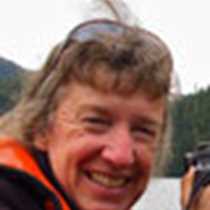Devil Island and Brown Bluff
Along the fringes of a massive, frozen continent there is life. Life abundant enough to fill your senses before you step outside or even open your eyes. Such was the case this morning when the scent of the Adelie penguin colony on Devil Island wafted into our consciousness. The island wore a glittering collar of icebergs, sequined embellishments laid on a cobalt nape of sea. Up from the beach a flamboyant trim of garish pink guano was stitched over with stark black and white penguins, colors and textures on the landscape layered like a mola embroidery.
We threaded our way through the colony along the shoulder of a ridge and then skyward, to the peak of the devil’s horn. Numerous chicks were splayed out and panting in the warm sunshine, their coats transitioning from dust-bunny down to the sleek, trim plumage essential for cold water survival. Numerous climbing explorers shed their coats as well; this was evidenced by two huge piles of red parkas, one at the first shoulder of our climb and a second further up towards the peak. From our lofty perch our ship seemed toy-like as ant-driven Zodiacs sped back and forth, ferrying the inquisitive from ship to shore.
One individual stood out from all the rest, not for its flamboyance, but for its lack of conformity. A leucistic Adelie penguin came into the colony. Like the others, it spent a short time preening and getting its feathers in order before proceeding towards the downy chicks and an ensuing feeding chase. At this time, it seems to be doing as well as other members of the colony, only time will tell if this genetic wrinkle will be its downfall.
Life came porpoising out of the water in Fridtjof Sound. Hundreds if not thousands of penguins and cormorants pulsed through the waters, all needing to fill their bellies if not for themselves, then for chicks waiting on shore.
In the late afternoon we strolled along the pebbled beach of Brown Bluff on the Antarctic peninsula. The late afternoon sun illuminated small bits of molted chick down flying through the air like soft confetti, and with this flurry of feathers swirling about our heads we headed home. Satiated with the abundance of life we had found along the thawed fringes of a frozen continent.
Along the fringes of a massive, frozen continent there is life. Life abundant enough to fill your senses before you step outside or even open your eyes. Such was the case this morning when the scent of the Adelie penguin colony on Devil Island wafted into our consciousness. The island wore a glittering collar of icebergs, sequined embellishments laid on a cobalt nape of sea. Up from the beach a flamboyant trim of garish pink guano was stitched over with stark black and white penguins, colors and textures on the landscape layered like a mola embroidery.
We threaded our way through the colony along the shoulder of a ridge and then skyward, to the peak of the devil’s horn. Numerous chicks were splayed out and panting in the warm sunshine, their coats transitioning from dust-bunny down to the sleek, trim plumage essential for cold water survival. Numerous climbing explorers shed their coats as well; this was evidenced by two huge piles of red parkas, one at the first shoulder of our climb and a second further up towards the peak. From our lofty perch our ship seemed toy-like as ant-driven Zodiacs sped back and forth, ferrying the inquisitive from ship to shore.
One individual stood out from all the rest, not for its flamboyance, but for its lack of conformity. A leucistic Adelie penguin came into the colony. Like the others, it spent a short time preening and getting its feathers in order before proceeding towards the downy chicks and an ensuing feeding chase. At this time, it seems to be doing as well as other members of the colony, only time will tell if this genetic wrinkle will be its downfall.
Life came porpoising out of the water in Fridtjof Sound. Hundreds if not thousands of penguins and cormorants pulsed through the waters, all needing to fill their bellies if not for themselves, then for chicks waiting on shore.
In the late afternoon we strolled along the pebbled beach of Brown Bluff on the Antarctic peninsula. The late afternoon sun illuminated small bits of molted chick down flying through the air like soft confetti, and with this flurry of feathers swirling about our heads we headed home. Satiated with the abundance of life we had found along the thawed fringes of a frozen continent.




